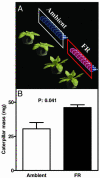Remote sensing of future competitors: impacts on plant defenses
- PMID: 16632610
- PMCID: PMC1459035
- DOI: 10.1073/pnas.0509805103
Remote sensing of future competitors: impacts on plant defenses
Abstract
Far-red radiation (FR) reflected by green tissues is a key signal that plants use to detect the proximity of future competitors. Perception of increased levels of FR elicits a suite of responses collectively known as the shade-avoidance syndrome, which includes increased stem elongation, production of erect leaves, and reduced lateral branching. These responses improve the access to light for plants that occur in crowded populations. Responses to the proximity of competitors are known to affect the susceptibility to disease and predation in several organisms, including social animals. However, the impacts of warning signals of competition on the expression of defenses have not been explicitly investigated in plants. In the experiments reported here, we show that reflected FR induced a dramatic down-regulation of chemical defenses in wild tobacco (Nicotiana longiflora). FR altered the expression of several defense-related genes, inhibited the accumulation of herbivore-induced phenolic compounds, and augmented the performance of the specialist herbivore Manduca sexta. Complementary studies with tomato suggested that the effects of FR on defenses are mediated by the photoreceptor phytochrome B. The central implication of these results is that shade-intolerant species such as wild tobacco and tomato activate functional changes that affect their ability to cope with herbivore attack in response to phytochrome signals of future competition, even in the absence of real competition for resources. These findings suggest that competition overshadowed herbivory during the evolution of this group of species and add a new axis to the definition of the shade-avoidance syndrome.
Conflict of interest statement
Conflict of interest statement: No conflicts declared.
Figures




Similar articles
-
Trading direct for indirect defense? Phytochrome B inactivation in tomato attenuates direct anti-herbivore defenses whilst enhancing volatile-mediated attraction of predators.New Phytol. 2016 Dec;212(4):1057-1071. doi: 10.1111/nph.14210. Epub 2016 Sep 30. New Phytol. 2016. PMID: 27689843
-
No time for candy: passionfruit (Passiflora edulis) plants down-regulate damage-induced extra floral nectar production in response to light signals of competition.Oecologia. 2013 Sep;173(1):213-21. doi: 10.1007/s00442-013-2721-9. Epub 2013 Jul 10. Oecologia. 2013. PMID: 23839264
-
The shade avoidance syndrome in Arabidopsis: the antagonistic role of phytochrome a and B differentiates vegetation proximity and canopy shade.PLoS One. 2014 Oct 21;9(10):e109275. doi: 10.1371/journal.pone.0109275. eCollection 2014. PLoS One. 2014. PMID: 25333270 Free PMC article.
-
Shedding (far-red) light on phytochrome mechanisms and responses in land plants.Plant Sci. 2014 Mar;217-218:36-46. doi: 10.1016/j.plantsci.2013.11.013. Epub 2013 Nov 28. Plant Sci. 2014. PMID: 24467894 Review.
-
Light regulation of plant defense.Annu Rev Plant Biol. 2014;65:335-63. doi: 10.1146/annurev-arplant-050213-040145. Epub 2014 Jan 23. Annu Rev Plant Biol. 2014. PMID: 24471835 Review.
Cited by
-
Shade avoidance.Arabidopsis Book. 2012;10:e0157. doi: 10.1199/tab.0157. Epub 2012 Jan 19. Arabidopsis Book. 2012. PMID: 22582029 Free PMC article.
-
Changes in light quality alter physiological responses of soybean to thiamethoxam.Planta. 2016 Sep;244(3):639-50. doi: 10.1007/s00425-016-2531-5. Epub 2016 Apr 25. Planta. 2016. PMID: 27114265
-
Kinome profiling reveals an interaction between jasmonate, salicylate and light control of hyponastic petiole growth in Arabidopsis thaliana.PLoS One. 2010 Dec 8;5(12):e14255. doi: 10.1371/journal.pone.0014255. PLoS One. 2010. PMID: 21170386 Free PMC article.
-
Jasmonate and phytochrome A signaling in Arabidopsis wound and shade responses are integrated through JAZ1 stability.Plant Cell. 2010 Apr;22(4):1143-60. doi: 10.1105/tpc.109.067728. Epub 2010 Apr 30. Plant Cell. 2010. PMID: 20435902 Free PMC article.
-
Arabidopsis downy mildew effector HaRxL106 suppresses plant immunity by binding to RADICAL-INDUCED CELL DEATH1.New Phytol. 2018 Oct;220(1):232-248. doi: 10.1111/nph.15277. New Phytol. 2018. PMID: 30156022 Free PMC article.
References
Publication types
MeSH terms
Substances
LinkOut - more resources
Full Text Sources
Other Literature Sources

